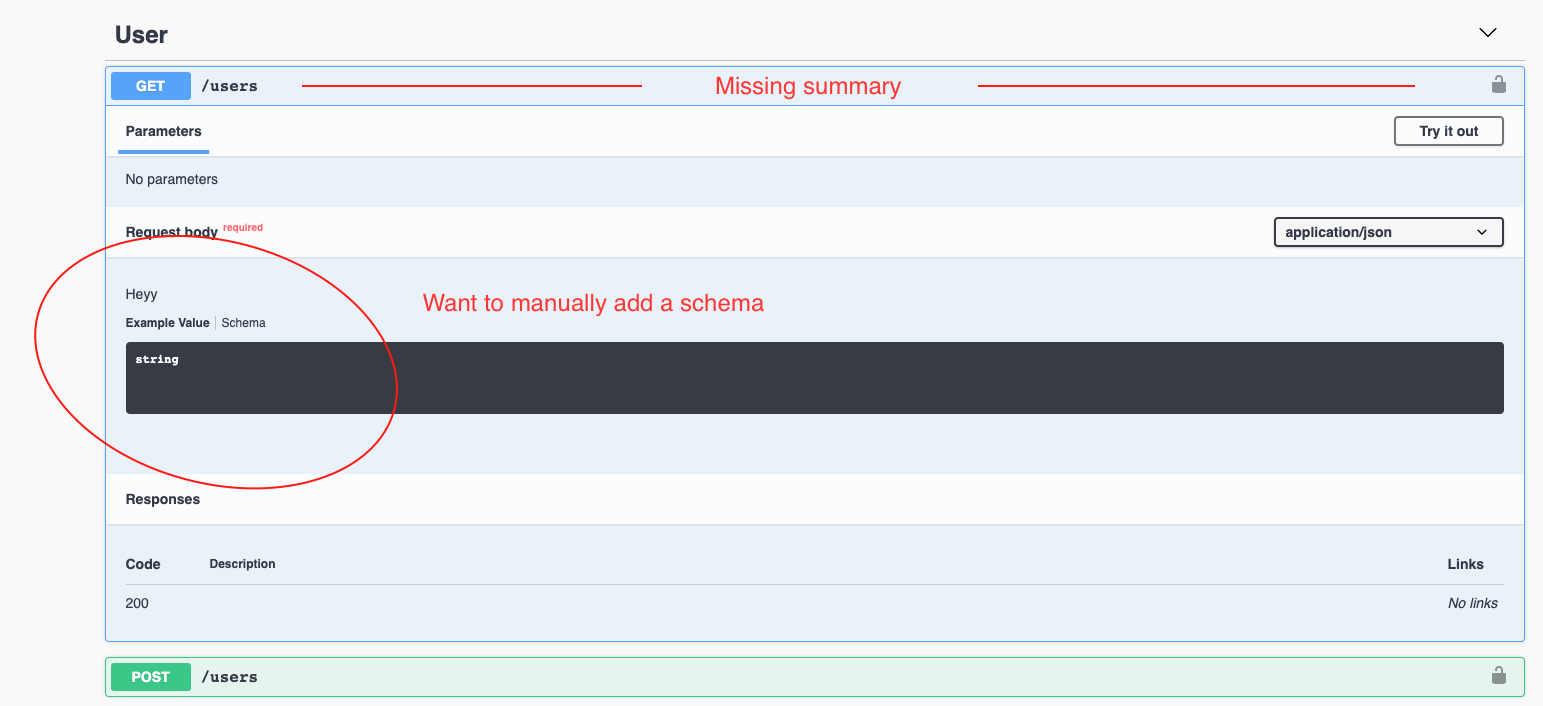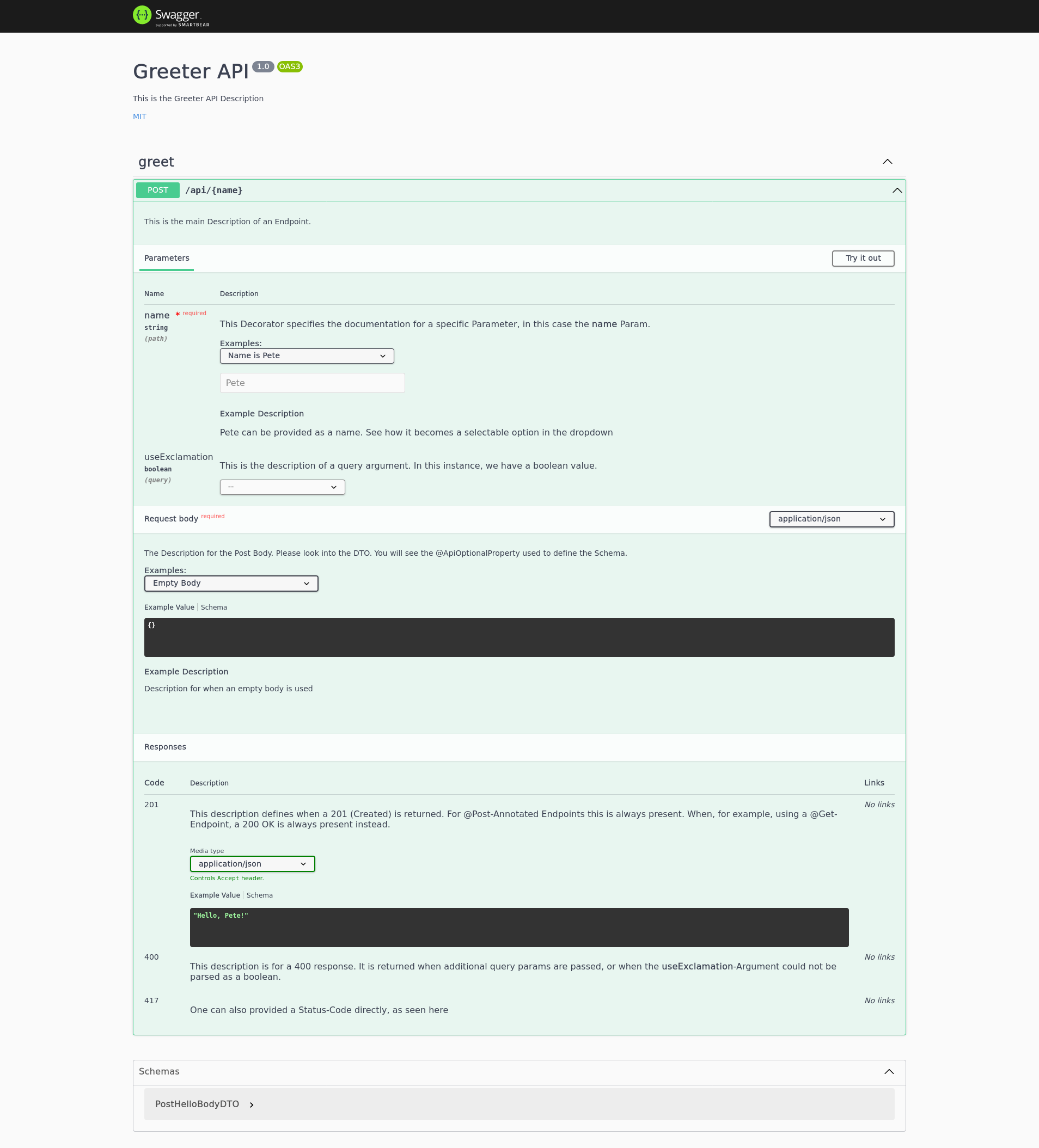Как добавить резюме и тело вручную в Swagger nestjs
Я пытаюсь добавить резюме в свои маршруты документации swagger, но не могу найти подходящий декоратор для определения резюме.
Есть несколько маршрутов, в которых я не указал DTO. Итак, я хотел бы вручную добавить тело запроса для этой конечной точки.
user.controller.ts
@Controller('users')
@ApiTags('User')
@ApiBearerAuth()
export class UsersController {
constructor(private readonly service: UsersService) {}
@Get()
async findAll() {
const data = await this.service.findAll();
return {
statusCode: 200,
message: 'Users retrieved successfully',
data,
};
}
}
auth.controller.ts
@UseGuards(AuthGuard('local'))
@Post('login')
@ApiParam({
name: 'email',
type: 'string'
})
@ApiParam({
name: 'password',
type: 'string'
})
async login(@Request() req) {
return this.authService.login(req.user);
}
4 ответа
Для сводки конечной точки вы можете использовать @ApiOperation(). Для схемы вы можете использовать@ApiResponse()
@Get()
@ApiOperation({ summary: 'summary goes here' })
@ApiResponse({ status: 200, description: 'description goes here', schema: { ...define schema here... } })
async findAll() {}
Подробнее о сырых определениях читайте в документации здесь: https://docs.nestjs.com/recipes/swagger
Я предполагаю, что это можно рассматривать скорее как ссылку, поскольку этот пост появляется при поиске инструкций для Swagger/OpenAPI.
Я создал пример репо, который показывает основное использование. Вы можете найти его здесь: https://gitlab.com/WaldemarLehner/nestjs-swagger-example
Отсутствует сводка
Использовать
@ApiOperation-Decorator для определения Endpoint-Description.
@ApiOperation({description: "This is the main Description of an Endpoint."})
Хотите вручную добавить схему запроса
Прежде всего, обратите внимание, что у вас есть GET-Endpoint. В результате любой запрос к этой конечной точке не может иметь тело запроса .
Итак... предполагая, что вы используете HTTP-метод, который допускает тело запроса (например, POST), вы можете использовать
@ApiBody-Декоратор.
Здесь вы можете определить Body-Summary, Schema (используя объект OpenAPI-Schema Object) или тип (Schema выводится из класса и его декораторов).
@ApiBody({
type: PostHelloBodyDTO,
description: "The Description for the Post Body. Please look into the DTO. You will see the @ApiOptionalProperty used to define the Schema.",
examples: {
a: {
summary: "Empty Body",
description: "Description for when an empty body is used",
value: {} as PostHelloBodyDTO
},
b: {
summary: "Hello Body",
description: "Hello is used as the greeting",
value: {greeting: "Hello"} as PostHelloBodyDTO
}
}
})
Дополнительная ссылка
Использование следующих украшений приведет к созданию документа Swagger, как показано ниже.
@ApiOperation({description: "This is the main Description of an Endpoint."})
/// Request Documentation
@ApiParam({
name: "name",
description: "This Decorator specifies the documentation for a specific Parameter, in this case the <b>name</b> Param.",
allowEmptyValue: false,
examples: {
a: {
summary: "Name is Pete",
description: "Pete can be provided as a name. See how it becomes a selectable option in the dropdown",
value: "Pete"
},
b: {
summary: "Name is Joe",
value: "Joe"
}
}
})
@ApiQuery({
name: "useExclamation",
description: "This is the description of a query argument. In this instance, we have a boolean value.",
type: Boolean,
required: false // This value is optional
})
@ApiBody({
type: PostHelloBodyDTO,
description: "The Description for the Post Body. Please look into the DTO. You will see the @ApiOptionalProperty used to define the Schema.",
examples: {
a: {
summary: "Empty Body",
description: "Description for when an empty body is used",
value: {} as PostHelloBodyDTO
},
b: {
summary: "Hello Body",
description: "Hello is used as the greeting",
value: {greeting: "Hello"} as PostHelloBodyDTO
}
}
})
/// Response Documentation
@ApiOkResponse({
description: "This description defines when a 200 (OK) is returned. For @Get-Annotated Endpoints this is always present. When, for example, using a @Post-Endpoint, a 201 Created is always present",
schema: {
type: "string",
example: "Hello, Pete!"
// For instructions on how to set a Schema, please refer to https://github.com/OAI/OpenAPI-Specification/blob/main/versions/3.0.3.md#schema-object-examples
}
})
@ApiBadRequestResponse({
description: "This description is for a 400 response. It is returned when additional query params are passed, or when the <b>useExclamation</b>-Argument could not be parsed as a boolean."
})
@ApiResponse({
status: 417,
description: "One can also provided a Status-Code directly, as seen here"
})
@Post(":name")
public postHello(...){...}
Результат
Я бы предложил создать DTO для всех ваших конечных точек (resp и req).
Вот как бы вы добавили сводку к схеме (на скриншоте щелкните "схема" в области, обведенной красным) с помощью декоратора DTOs + @ApiProperty.
import { ApiProperty } from '@nestjs/swagger';
export class ExampleRedditDTO {
@ApiProperty({
type: String,
description: "The target subreddit"
})
targetSub!: string;
@ApiProperty({
type: Number,
description: "The number of top posts you want back"
})
postCount!: number;
}
Если кто-то ищет решение в новой версии Quarkus/OpenAPI, то вот решение:
- Добавляем тело запроса:
@RequestBody(content = @Content(
examples = {@ExampleObject(name = "Testing Name", value = "{'name':'Abc', 'age':23}", description = "Testing Description")}))
- Добавление резюме:
@Operation(summary = "Testing GitHub File Reader")
Вместе:
import org.eclipse.microprofile.openapi.annotations.Operation;
import org.eclipse.microprofile.openapi.annotations.media.Content;
import org.eclipse.microprofile.openapi.annotations.media.ExampleObject;
import org.eclipse.microprofile.openapi.annotations.parameters.RequestBody;
import javax.ws.rs.Consumes;
import javax.ws.rs.POST;
import javax.ws.rs.Path;
import javax.ws.rs.Produces;
import javax.ws.rs.core.MediaType;
import java.util.Map;
@Path("/api")
public class RestControllerResponse {
@Path("/generate")
@POST
@Operation(summary = "Testing GitHub File Reader")
@Consumes({MediaType.APPLICATION_JSON, MediaType.APPLICATION_XML})
@Produces({MediaType.APPLICATION_JSON, MediaType.APPLICATION_XML})
@RequestBody(content = @Content(
examples = {@ExampleObject(name = "Testing Name", value = "{'name':'Abc', 'age':23}", description = "Testing Description")}))
public String generator(final Map<String, Object> input) throws Exception {
return "Hello From Generator Method";
}
}

